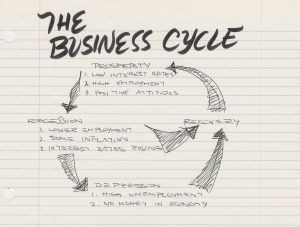This is the last article in our study of Chapter 20, Section 9 of Human Action. We end here our discussion about the impact of business cycle on the market. And we will focus our attention on the charges against free market advanced by nonmonetary theorists of business cycle known as “disproportionality doctrines.”
In the previous article, we mentioned that nonmonetary theorists of the business cycle explain an inherent contradiction within the free market as the real cause of business boom and bust. They identified it as the “disproportionality in the size of investments made in various branches of industry” (p. 582). And the two most popular disproportionality doctrines are “durable goods doctrine” and “acceleration principle.” Let us give a brief definition of each of them.
Durable goods doctrine is an economic belief that:
“…goods retain their serviceableness for some time. As long as their life period lasts, the buyer who has acquired a piece abstains from replacing it by the purchase of a new one. Thus, once all people have made their purchases, the demand for new products dwindles. Business becomes bad. A revival is possible only when, after the lapse of some time, the old houses, cars, refrigerators, and the like are worn out, and their owners must buy new ones” (p. 583).
Acceleration principle on the other hand is:
“A temporary rise in the demand for a certain commodity results in increased production of the commodity concerned. If demand later drops again, the investments made for this expansion of production appear as mal investments. This becomes especially pernicious in the field of durable producers’ goods” (p. 584).
Responding to the first accusation against free market, Mises argued:
“There are, to be sure, always promoters who in a mood of deceptive optimism are prone to over expand their enterprises. In the pursuit of such projects they snatch away factors of production from other plants of the same industry and from other branches of industry. Thus their overexpansion results in a relative restriction of output in other fields. One branch goes on expanding while others shrink until the unprofitability of the former and the profitability of the latter rearranges conditions. Both the preceding boom and the following slump concern only a part of business” (p. 584).
Mises’ response shows that the accusation is unsound for in the trade cycle, not only part of a business is affected. In fact, almost all entrepreneurs suffer financial lost. Durable goods doctrine cannot provide a reasonable explanation for this economic phenomenon.
Responding to acceleration principle, Mises explains that:
“The fundamental error of this doctrine is that it considers entrepreneurial activities as a blindly automatic response to the momentary state of demand. Whenever demand increases and renders a branch of business more profitable, production facilities are supposed instantly to expand in proportion. This view is untenable. Entrepreneurs often err. They pay heavily for their errors. But whoever acted in the way the acceleration principle describes would not be an entrepreneur, but a soulless automaton” (p. 584).
Mises then goes on to describe the character of a real entrepreneur as speculator. By this, he meant the quality of an entrepreneur to have an “anticipative understanding.” This quality is basically instinctive and cannot be learned in school. No existing rules could assess the presence of this entrepreneurial quality. An entrepreneur according to Mises is not guided by what was and is, but by how he sees the future.
Concluding his refutation of disproportionality doctrines, Mises claims that even if the arguments of nonmonetary theorists are accepted as valid, still they could not sufficiently explain how businessmen could proceed in expanding their business apart from credit expansion caused by increase in money supply. Only monetary credit theory of business cycle could provide reasonable explanation for business expansion caused by credit expansion.

No comments:
Post a Comment